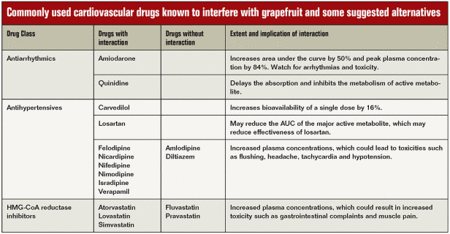Important considerations for grapefruit and drug interaction
Tangelos are a great alternative for patients who do not want to cut grapefruit out of their diet.
Tart, tangy and sweet, grapefruit has long been a popular citrus choice, especially during winter and spring, the fruit’s peak growing season.
From a nutritional standpoint, the choice makes a lot of sense. Grapefruit is high in vitamin C, fiber, vitamin A, potassium and folate, and low in calories. Grapefruit also contains lycopene and limonoids, is touted to have antitumor activity, and contains limonin, which may have LDL- and triglyceride-lowering properties.
|
|
The American Heart Association includes grapefruit on its list of recommended foods, and The South Beach Diet, popularized by cardiologist Arthur Agatston, MD, considers grapefruit one of its staples. He recommends consumption of grapefruit in seven out of 14 days in the phase-three meal planner, due to its low glycemic index and high vitamin content. So it should not be surprising that many patients with heart disease, those likely to be referred to the AHA or The South Beach Diet for help with dietary lifestyle modification, eat grapefruit or drink grapefruit juice regularly.
However, what is often forgotten is that along with a favorable nutrition profile, grapefruit comes with an objectionable chemical profile.
A chemical reaction
For almost two decades, it has been known that grapefruit and grapefruit juice increase the bioavailability of certain oral drugs. Chemicals in the grapefruit called furanocoumarin monomers and dimers, which may help plants repel hungry animals, have been identified as the culprit. Furanocoumarins inhibit the intestinal P-450 enzyme and cytochrome P-450 3A4 (CYP3A4), which is responsible for the metabolism of some drugs. CYP3A4 is also present in the liver, but unless grapefruit is ingested in very large quantities, it does not have an effect on hepatic CYP3A4.
There are six main furanocoumarin monomer and dimer components thought to be primarily responsible for inhibiting CYP3A4. However, there are at least 20 varieties present in grapefruit. The amount of each furanocoumarin in any grapefruit crop can vary by as much as fourfold to 65-fold, based on growing conditions, the time fruit is picked during the growing season, grapefruit type (red vs. white) and consumption temperature (refrigerated vs. room temperature). In juice, the amount varies based upon whether it was made from concentrate.
Co-administration of grapefruit and drugs metabolized by intestinal CYP3A4 results in a significantly greater amount of drug available due to reduced metabolism. Importantly, this effect is not predictable because of the varying amounts of furocoumarins in grapefruit products, as well as genetic variability in CYP3A4. As a result, the pharmacodynamic effect of co-administered drugs, particularly those with a narrow therapeutic index, is exaggerated, as can be the adverse effect profile.

In a study that was reported in a 2006 issue of The American Journal of Clinical Nutrition, volunteers were assigned felodipine, a calcium antagonist known to be metabolized by CYP3A4, and regular grapefruit juice, a grapefruit juice product from which all the furanocoumarins were removed, and orange juice (control) in a randomized crossover design. Compared with the furanocoumarin-free grapefruit juice and orange juice, grapefruit juice resulted in a fourfold increase in the maximum concentration of felodipine observed in the volunteers.
If these findings are confirmed in subsequent studies, commercialization of a furanocoumarin-free grapefruit juice could provide a satisfactory alternative for patients who are taking medications with interaction potential, the researchers concluded.
There may be a readily available alternative to grapefruit for those who take interfering drugs and are not willing to wait for a furanocoumarin-free product to satisfy a craving for that tart, tangy taste. Tangelos are a cross between tangerines and grapefruit. In a study testing 13 tangelo varieties grown in Florida, the hybrid was found to contain between 12.5% and 50% grapefruit DNA. However, when tested for furanocoumarins, only one variety was found to have trace amounts, though not large enough to cause any drug interaction, and the others were furanocoumarin free.
So for those patients who just can’t kick the grapefruit habit, recommend they try tangelos as a safe alternative.
Rhonda Cooper-DeHoff, Pharm D, is Assistant Director of Clinical Programs and Research Assistant Professor in the Division of Cardiology at University of Florida College of Medicine, Gainesville. She is a member of the Today in Cardiology’s Editorial Board.
For more information:
- Paine MF, Widmer WW, Hart HL, et al. A furanocoumarin-free grapefruit juice establishes furanocoumarins as the mediators of the grapefruit juice–felodipine interaction. Am J Clin Nutr. 2006;83:1097-1105.
- Widmer W. One tangerine/grapefruit hybrid (tangelo) contains trace amounts of furanocoumarins at a level too low to be associated with grapefruit /drug interactions. Journal of Food Science. 2005;70:C419-C422.










